 |
|
Artistic fascination with scripts and words is profoundly rooted in the desire to manipulate line, form, space, color and perspective. Many contemporary African artists use conventional and invented scripts along with graphic symbols to explore the inherent tensions between visual forms--the way letters, words or inscriptions look--and their meanings both within and outside the artworks themselves. They harness the narrative elements and plasticity of script to create complex, cosmopolitan artworks that address the communicative powers of language.
Artists draw not only upon traditional African uses of scripts but also upon a rich history in modern and postmodern artistic practice that manipulates words to serve multiple aesthetic and communicative functions. Whether working in photography, painting, mixed media or site-specific installations, African artists move beyond simple investigations of script and calligraphy to produce highly personal and poetic approaches to text and image.
|
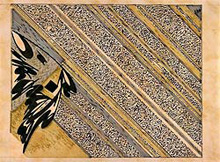
Calligrams
Nja Mahdaoui born 1937, Tunisia
Ink on paper
H x W: 41.2 x 51 cm (16 1/4 x 20 1/16 in.)
Purchased with funds provided by the Smithsonian Collections
Acquisition Program
96-20-13
Nja Mahdaoui regards text as an intricate part of composition, carefully balancing language with visual form. In so doing, he creates a rhythmic, even melodic, flow that unites the detailed calligraphy with forms and colors.
Mahdaoui emerged from a generation of North African artists of the 1960s that sought to revolutionize calligraphy as an art form. Traditionally reserved for recording the word of God as set down in the Qur'an, calligraphy was considered a sacramental art, for the words themselves embodied the Prophet Muhammad's blessings. Attitudes towards calligraphy changed with the rise of anti-colonial struggles and globalization, thus enabling Mahdaoui and others to explore it as art in its own right.
|
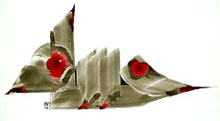
Husam alsalam
Osman Waqialla born 1925, Sudan
ca. 1988
Ink and gouache on paper
H x D: 41.0 x 58.5 cm (16 1/8 x 23 1/16 in.)
Purchased with funds provided by the Smithsonian Collections
Acquisition Program
96-25-4
In this work, Osman Waqialla celebrates the beauty of Arabic calligraphy. Waqialla's body of artwork clearly indicates an interest in deconstructing scripts and distilling them to their elemental forms, but he was also concerned with the meanings of letters and words. A pioneer at the College of Fine and Applied Arts in Khartoum, Waqialla is admired for having skillfully adapted traditional calligraphic techniques and forms into a contemporary idiom.
|
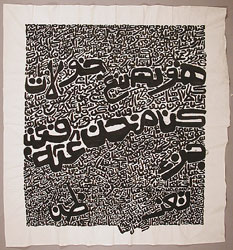
Samira's Story
Fathi Hassan, born 1957, Egypt (Nubia)
1995
Acrylic on canvas
H x W: 250 x 250 cm. (98 27/64 x 98 27/64 in.)
TC2003.10.2 Loan from artist
In his works Fathi Hassan often addresses the power relations between oral practices and the written word. He places particular emphasis on the plight of lost languages, such as that of ancient Nubia, through the domination of those imposed by colonial-era policies. Most of his scripts are deliberately illegible, invented forms that allude to Arabic kufic calligraphy but yield little direct information. By playing graphic symbolism against literal meaning, Hassan questions the largely Western assumption that the written word provides the best access to reality.
|
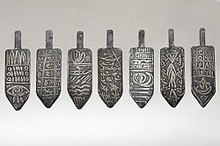
Amulets
Rachid Kora´chi, b. 1947, Algeria
1994
Steel
H x W x D: 16.7 x 5.2 x .1 cm each (group of 49 amulets); (6 37/64 x 2 3/64 x 25/64 in. each)
Sackler, S1998.158.1-49
Inspired by the forms and shapes of the Arabic alphabet, Rachid Kora´chi is intrigued by the mystic traditions of Sufism and its appreciation of letters as signs and gestures. With these 49 amulets, Kora´chi created his own system of letters and signs that are etched on the surface of small, polished steel plaques. Numbers, geometric shapes, crescent moons, scarabs and a variety of letters-some resemble Arabic or Japanese characters-enliven the work. According to Kora´chi, these amulets are meant to be viewed in multiples of seven, a mystical number in Islam. Much like symbols on talismans that protect against evil and misfortune, Kora´chi's motifs lend his amulets a sense of power and mystery.
Kora´chi uses his art to bridge gaps between art and craft, Africa and the world, and modern practices and ancient traditions. He often works with local potters, weavers and blacksmiths, relying on their genius to achieve the desired end results in his art.
|
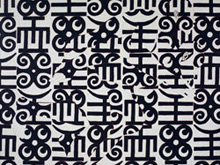
Off My Back
Kwesi Owusu-Ankomah born 1956, Ghana
1995
Acrylic on canvas
H x W: 157.1 x 211.7 cm (61 7/8 x 83 3/8 in.)
Museum purchase
2000-17-1
The intertwined bodies of two wrestlers emerge from this richly patterned composition enlivened by symbols from the Ghanaian graphic system adinkra. In this work Kwesi Owusu-Ankomah reproduces adinkra symbols either directly or with subtle variations, employing motifs such as the akoben (the war horn) and dwannimen notoaso (the ram's horns). Generous amounts of black acrylic paint approximate the thick dye that is used to produce the stamped adinkra patterns on cloth. As here, Owusu-Ankomah often adds figures engaged in combat or sport to heighten the overall patterning effect. The artist's use of adinkra symbols not only visually unifies the work and the action therein but also integrates indigenous traditions with modernist technique and form.
|
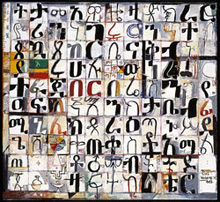
The Color of Words IX
Wosene Worke Kosrof, b. 1950, Ethiopia
2002
Acrylic on linen
H x W: 79 x 87 cm. (31 7/64 x 34 _ in.)
Private collection (Susan Saul)
Wosene Worke Kosrof considers his recent works to be investigations into a new alphabet, one that employs a vocabulary of signs and symbols to link past with present, and Africa with the diaspora in which he works and lives. Drawing upon Ethiopian graphic systems, liturgical symbols and architectural forms as well as pan-African motifs, the artist produces richly colored and detailed canvases. Wosene's fascination with words and the seductive forms of written signs are contemplated alongside other investigations of language and identity within modern histories of Africa. In his Color of Words series, Wosene blends color and shapes, the verbal and the visual, into lively compositions that celebrate the richness of language.
|
|

|










